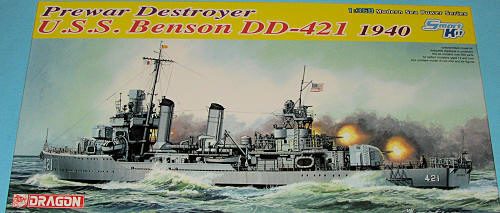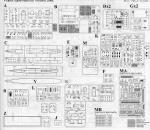
| KIT #: | 1034 |
| PRICE: | $49.95 SRP |
| DECALS: | One option |
| REVIEWER: | Scott Van Aken |
| NOTES: |

| HISTORY |
The Benson class was a class of 30 destroyers of the U.S. Navy built 1939–1943. The first ship of the class was the USS Benson. The U.S. Navy customarily names a class of ships after the first ship of the class; hence the Benson class.
It was named after William Shepherd Benson, a graduate of the Naval Academy in 1877. He commanded the USS Albany, USS Missouri, USS Utah, and the Philadelphia Navy Yard. Benson was appointed first Chief of Naval Operations in 1915 and then served as CNO until he retired 25 September 1919. He died in Washington, D.C., 20 May 1932.
The Benson class was designed as an improved version of the Sims class with two stacks and a new machinery arrangement that featured alternating boiler and engine rooms designed to give the ships a better chance at surviving torpedo damage. Their scantlings, or framing dimensions, were increased to carry the weight of the new machinery. This increased the ship's displacement by about sixty tons. The Benson-class destroyer was the backbone of the pre-war Neutrality Patrols and brought the action to the enemy by participating in every major campaign of the war.
Commissioned on July 25 1940, the USS Benson was in time to see extended combat during WWII. The USS Benson (DD-421), the only ship of this name in the U.S. Navy thus far, was the lead ship in a class of destroyers. Before the USA entered the war, the vessel was escorting convoys to and from Iceland. Subsequent to the events of Pearl Harbor, it was again escorting convoys, this time to the UK. An at-sea collision prevented its participation in the landings in North Africa, although it did support the later invasion of Sicily and the landings at Salerno. In 1944 it was fully engaged in convoy duties in the Mediterranean, and succeeded in shooting down several German aircraft. It also supported the invasion of southern France. The final weeks of WWII were spent in the Pacific. Its valorous WWII service earned the ship four battle stars.
She was decommissioned there on 18 March 1946, placed in reserve, and assigned to the Charleston Group of the Atlantic Reserve Fleet. On 26 February 1954, Benson was transferred to the government of the Republic of China, and she served the Republic of China Navy as Lo Yang (DD-14) into the mid-1970s. As the result of a survey made of her early in 1974, the Taiwanese replaced her with another American destroyer that the Navy loaned them in 1975, the former USS Taussig (DD-746), which then became Lo Yang (DD-14). Meanwhile, Benson’s name was struck from the Naval Vessel Register on 1 November 1974; and she was sold to Taiwan, presumably for cannibalization and scrapping.
| THE KIT |
 Some of you may be wondering why another 1/350 USS Benson. It may be the same ship, but the kit has quite a different setup. An abundant assortment of brand new parts includes a replacement hull made by slide molds. A completely new hull was called for due to important differences from that of the 1945 build that was initially released. The aft superstructure and deck are also new, as is the main mast with its crow’s nest. Other differences between the two kits are the rangefinder, .50-cal AA guns, and the blast shield for the aft torpedo launcher. A generous selection of photo-etched parts is available for items such as the sky-lookout shield and various ladders. You'll still need to go aftermarket for your railings, though.
Some of you may be wondering why another 1/350 USS Benson. It may be the same ship, but the kit has quite a different setup. An abundant assortment of brand new parts includes a replacement hull made by slide molds. A completely new hull was called for due to important differences from that of the 1945 build that was initially released. The aft superstructure and deck are also new, as is the main mast with its crow’s nest. Other differences between the two kits are the rangefinder, .50-cal AA guns, and the blast shield for the aft torpedo launcher. A generous selection of photo-etched parts is available for items such as the sky-lookout shield and various ladders. You'll still need to go aftermarket for your railings, though.
Here are the kit features;
- Newly tooled one-piece upper hull w/undercut detail thanks to slide-mold technology
- Sky-lookout shield reproduced w/photo-etched parts
- Quintuple torpedo launcher w/fine detail
- Second torpedo launcher w/accurate deflector blast shield
- Additional open port holes are molded w/details
- Deck has realistically produced camber
- Waterline or full-hull version can be assembled
- Additional whalers are produced for Benson DD-421
- Sponsors are represented on lower hull by slide-mold technology
- Flat-sided funnels for Benson-class destroyer like U.S.S. Laffey
- Funnels provided w/option of molded-on ladders or add-on photo-etched ladders
- Separate piping on rear of tunnel
- Realistic photo-etched funnel cap grills and funnel platform
- Extremely fine detailed parts like davits for whalers
- Depth charges molded w/extra fine details
- Bridge supports finely represented w/photo-etched parts
- Side doors (w/optional photo-etched parts) can be assembled open/closed
- Extra-fine detail on superstructure walls like hose and ladder patterns delicately reproduced
- Authentic aft superstructure w/details like ladders and surface detail included
- True-to-scale .50-cal AA gun
- Gun turrets w/realistic detail
- Gun barrels are slide-molded w/hollow ends
- Special device included to bend specific photo-etched parts to correct angles
- Rudder is movable
- True-to-scale ultra-thin propellers reproduced
- Delicate aft deckhouse w/authentic detail
- Upper open mount and lower mount 5-inch guns realistically reproduced
- Realistic mast and crow's nest reproduced
- Accurate stern jackstaff w/running lights
- Smoke generators w/fine details
- Photo-etched propeller guards finely reproduced
- Optional barrels provided for gun turrets
As usual, the instructions are quite complete and at times, a bit complex. As usual this can be built as either a waterline or a full hull model and a stand is provided for that option. I should also mention that often times, the photo etch parts are optional replacements for the standard plastic bits. This is important to those who are not fond of p.e.
| CONCLUSIONS |
Personally, I like the pre-war color scheme for US ships a lot more than the darker wartime colors that were used. I'm hoping that we'll get to see more early and pre-war destroyers from Dragon.
| REFERENCES |
http://en.wikipedia.com Dragon USA
May 2011 Thanks towww.dragonmodelsusa.com for the preview kit. Get yours today at your local shop or on-line retailer
If you would like your product reviewed fairly and fairly quickly, please contact the editor or see other details in the